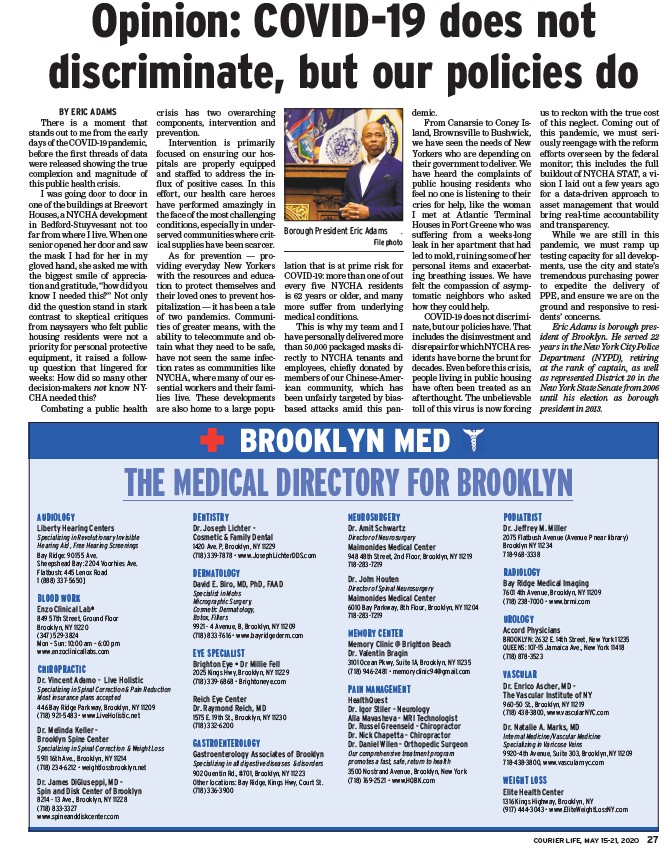
Opinion: COVID-19 does not
discriminate, but our policies do
��������������������������������������������������������������������
COURIER LIFE, MAY 15-21, 2020 27
BY ERIC ADAMS
There is a moment that
stands out to me from the early
days of the COVID-19 pandemic,
before the fi rst threads of data
were released showing the true
complexion and magnitude of
this public health crisis.
I was going door to door in
one of the buildings at Breevort
Houses, a NYCHA development
in Bedford-Stuyvesant not too
far from where I live. When one
senior opened her door and saw
the mask I had for her in my
gloved hand, she asked me with
the biggest smile of appreciation
and gratitude, “how did you
know I needed this?” Not only
did the question stand in stark
contrast to skeptical critiques
from naysayers who felt public
housing residents were not a
priority for personal protective
equipment, it raised a followup
question that lingered for
weeks: How did so many other
decision-makers not know NYCHA
needed this?
Combating a public health
crisis has two overarching
components, intervention and
prevention.
Intervention is primarily
focused on ensuring our hospitals
are properly equipped
and staffed to address the infl
ux of positive cases. In this
effort, our health care heroes
have performed amazingly in
the face of the most challenging
conditions, especially in underserved
communities where critical
supplies have been scarcer.
As for prevention — providing
everyday New Yorkers
with the resources and education
to protect themselves and
their loved ones to prevent hospitalization
— it has been a tale
of two pandemics. Communities
of greater means, with the
ability to telecommute and obtain
what they need to be safe,
have not seen the same infection
rates as communities like
NYCHA, where many of our essential
workers and their families
live. These developments
are also home to a large population
that is at prime risk for
COVID-19: more than one of out
every fi ve NYCHA residents
is 62 years or older, and many
more suffer from underlying
medical conditions.
This is why my team and I
have personally delivered more
than 50,000 packaged masks directly
to NYCHA tenants and
employees, chiefl y donated by
members of our Chinese-American
community, which has
been unfairly targeted by biasbased
attacks amid this pandemic.
From Canarsie to Coney Island,
Brownsville to Bushwick,
we have seen the needs of New
Yorkers who are depending on
their government to deliver. We
have heard the complaints of
public housing residents who
feel no one is listening to their
cries for help, like the woman
I met at Atlantic Terminal
Houses in Fort Greene who was
suffering from a weeks-long
leak in her apartment that had
led to mold, ruining some of her
personal items and exacerbating
breathing issues. We have
felt the compassion of asymptomatic
neighbors who asked
how they could help.
COVID-19 does not discriminate,
but our policies have. That
includes the disinvestment and
disrepair for which NYCHA residents
have borne the brunt for
decades. Even before this crisis,
people living in public housing
have often been treated as an
afterthought. The unbelievable
toll of this virus is now forcing
us to reckon with the true cost
of this neglect. Coming out of
this pandemic, we must seriously
reengage with the reform
efforts overseen by the federal
monitor; this includes the full
buildout of NYCHA STAT, a vision
I laid out a few years ago
for a data-driven approach to
asset management that would
bring real-time accountability
and transparency.
While we are still in this
pandemic, we must ramp up
testing capacity for all developments,
use the city and state’s
tremendous purchasing power
to expedite the delivery of
PPE, and ensure we are on the
ground and responsive to residents’
concerns.
Eric Adams is borough president
of Brooklyn. He served 22
years in the New York City Police
Department (NYPD), retiring
at the rank of captain, as well
as represented District 20 in the
New York State Senate from 2006
until his election as borough
president in 2013.
Borough President Eric Adams .
File photo
������������������
����������������������������������������������
���������������������������������������������������������������������������������� ��
��������������������������������������������������������������������������
��������������������������������������������
��������������������������������������������������������������������
���������������������������������������������������� �� ��
����������������������������������
��������������������
������������������������������������
������������������������������������������������������������
��������������������������������������
������������������������������
������������������������������������������������������������
���������������������������������������������������� ��
������������������������
��������������������������������������������������������������������
������������������������������������������������������������������������������������������������������
����������������������������������������������������������
����������������������������������������������������������������������������������
��������������������������������������������������������������������������
������������������������������������������ �� ��
������������������������������������������
������������������������������������������������������������������������������������������������
��������������������������������������������������������������������
������������������������������������������������������������������������������
����������������������������������������������������
����������������������������������������������������������������
��������������������������������������������������������������������������
������������������������������ �� ��
����������������������������������������������������
������������������
������������������������������������������ �� ��
������������������������������������������������
��������������������������������������������������������������
����������������������������������������������������������������������������������
����������������������
��������������������������������������������������������
����������������������������������������
��������������������������������������������
����������������������������������������������
����������������������������
����������������������������������������������������������������������������
��������������������������������������������������������������������������
����������������������������
����������������������������������������������������������
��������������������������������������������������������������������
����������������������������������������������������������������
����������������������������������
������������������������������������������
����������������������������������������������������������������������������
����������������������������
��������������������������������
������������������������������������������������������������������������������
������������������������������������������������������������������������������������������������������
����������������������������������������������������������������������������������
������������������������������������������������������������������������������������������������
����������������������������
������������������������
������������������������������������ ��
������������������������������������������������
��������������������������������������������������
��������������������������������������������������������������������������������������������
������������������������
������������������������������
��������������������������������������������������������������
��������������������������������������������������
����������������������������������������������������������������������������������������������
������������������������
��������������������������
������������������������������������������������������������
��������������������������������������
����������������������������������������������������������������������������������������������
������������������������������������������������������������������������������������
������������������������������
������������������������
������������������������������������������������������
������������������������������������������������������������������
����������������������������������������������������������������������
����������������������������������������������������������������
��������������������������������������������������������������������������
��������������������������������������������������������������������������
������������������������������������������������������������������������������
��������������������������������������������������������������������������������
����������������������������������������������������������
��������������������
������������������������������������������
����������������������������������������������������������������������������������������
����������������������������������
�������������������������� �� ��
������������������
��������������������������������������������������
��������������������������������������������������������������������������
����������������������������������������������������������
��������������
����������������������������������
������������������������������������������������������������������������������������������
��������������������������������������������������������������������������������������
����������������������������
������������������
����������������������������������������������
��������������������������������������������������������
����������������������������������������������������������������
����������������������������������������������������������������������
������������������������������������������������
������������������������������������������������������������������������
������������������������������������������������������������
��������������������������������������������������������������������������������������������
������������������������������������������������������������������
������������������������
����������������������������������������
��������������������������������������������������������������������
������������������������������������������������������������������������������������